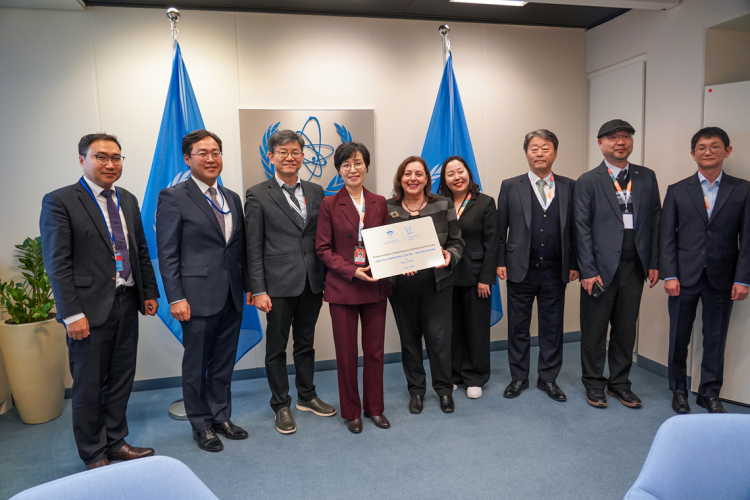At its Ministerial Conference on Nuclear Science, Technology and Applications and the Technical Cooperation Programme, the IAEA welcomed its newest Rays of Hope Anchor Centre: the Korea Institute of Radiological and Medical Sciences. The Institute joins four other Anchor Centres in the Asia Pacific - and ten others around the world - as knowledge and capacity-building hubs which will bolster the cancer care capabilities of neighbouring countries.
"Through the IAEA's Rays of Hope: Cancer Care for All initiative, the Agency has been expanding access to critical, life-saving cancer care tools - diagnostic imaging, nuclear medicine and radiotherapy - where it is needed most", said IAEA Director General Rafael Mariano Grossi on the at the signing with the Korea Institute of Radiological and Medical Sciences (KIRAMS). "With more 90 countries requesting support through Rays of Hope, the addition of KIRAMS to the IAEA's growing network of regional hubs reflects the importance of Anchor Centres as a key pillar for meeting cancer needs in every corner of the world."
From creating opportunities in cancer care to providing technical assistance to others within education, training, innovation, research and quality assurance, Anchor Centres play a central role in Rays of Hope's sustainability and long-term impact. These cancer leaders have a demonstrated record of collaboration with the IAEA; deep technical expertise; robust governance and medical infrastructure; and a long-term commitment to furthering cancer care.
Pleased to designate Korea Institute of Radiological & Medical Sciences as a #RaysOfHope Anchor Centre with Pres. Jin Kyung Lee at #IAEAMinisterial. We will also partner for more #WomenInScience through @IAEAorg's Marie Sklodowska-Curie Fellowship & Lise Meitner Programmes. pic.twitter.com/CCar5IH9h2
— Rafael MarianoGrossi (@rafaelmgrossi) November 27, 2024
"This designation as an IAEA Rays of Hope Anchor Centre is a remarkable acknowledgment of KIRAMS' contributions to the global fight against cancer through advancements in radiation medicine," said Jin Kyung Lee, President of KIRAMS. "We are committed to developing and sharing innovative radiation medicine technologies to strengthen the healthcare capacities of developing nations and to play a pivotal role in improving global health outcomes."
Since its establishment in 1963, KIRAMS has promoted multidisciplinary collaboration in research, education, training and patient management - leading to holistic solutions and innovative breakthroughs. Over the years, it has supported a number of IAEA human health projects to improve clinical outcomes for the region's cancer patients; strengthen the clinical application of a resource-sparing treatment approach (hypofractionated radiotherapy); standardize radiation therapy in palliative care; and facilitate regional collaboration through clinical networks. Among others, it has also strengthened the use of imaging modalities to manage non-communicable diseases; developed standards, education and training to augment medical physics services; and enhanced the Asia Pacific's capacities to produce cyclotron-based radiopharmaceuticals for imaging and treatment.
Over the previous decade, the institute has conducted nine IAEA courses - training over 300 radiation medicine professionals from across the region. KIRAMS has also hosted scientific visitors and fellows from neighbouring countries.
In 2011, KIRAMS signed a practical arrangement with the IAEA to provide expertise inbuilding sustainable cancer treatment capabilities in developing countries. Through a 2023 trilateral cooperation agreement with the Agency and the Ministry of Health of Mongolia, KIRAMS has been supporting Mongolia in expanding the country's nuclear medicine and radiation oncology capacities. Its assistance has included collaboration on advanced diagnostic technologies and radionuclide treatment.
As an Anchor Centre, KIRAMS will continue to cooperate closely with the IAEA by applying its expertise and experience to assist others. "Despite progress in the global availability of radiotherapy, the recently released Lancet Oncology Commission on Radiotherapy and Theranostics report highlights the need for innovative solutions which can increase access and efficiency - be it through the adoption of mitigating radiotherapy initiatives, the development of resource-sparing tools and technologies through research, or the adoption of more effective training approaches," noted May Abdel-Wahab, Director of the IAEA Division of Human Health. "Rays of Hope Anchor Centres serve as a timely mechanism to accelerate global momentum as regional engines of collaboration and cooperation."

IAEA Director of the Division of Human Health May Abdel-Wahab and KIRAMS President Jin Kyung Lee, together with representatives from KIRAMS. (Photo: KIRAMS)






